
Source: JPM Chase
“Stop trying to put 10 pounds of shit in a 5 pound bag.”
I had an editor who was very fond of telling me that. It was his way of suggesting I keep my columns short and tightly focused on one big issue.
Unlike blogging, where digressions can turn into tangents and then become diversions (and no one cares), professional publications (Bloomberg, Washington Post) requires the writing be structured and short. The trade-off is that related topic issues can get overlooked in a 750-word column.
This week’s discussion of Index Concentration is a good example. The key takeaway was the top 10 stocks in the S&P500 at a 27% weighting does not represent a specific threat; it was only a little above its 40-year range of 17.5% to 25.5%.
But that means a lot of related tangents I did not get much time to be delved into in that piece. Below are some ideas which I might also have liked to developed further:
• Denominator Blindness: I have seen a dozen commentaries, columns and analyses, all of which decried the concentrated risk of 27% for the top 10 or 22% for the top 5 stocks in the index. All declared it as risky, excessive, or dangerous — yet not one explained what the historical levels were. Nor did they explain why this concentration was risky.
One single number out of any context is classic denominator blindness.
• Absolute or Relative Performance: Why do we have a concentration of stocks in the top 5 or 10 holdings in the index? How did the current situation develop?
There are times when all stocks are doing well, When this occurs, it is merely the nature of a market cap weighted beast. Over time, capital flows benefit the biggest stocks the most and these holdings become larger as a percentage of the index. Other times, those stocks do incredibly well on their own, and because of that, they become larger. Their success attracts capital, they become even bigger. Quarterly index rebalancing can work to their advantage.
• Absolute AND Relative Performance: Then there has been 2020: Not only have the top 10 stocks done very well on their own, nearly all of the next 490 have done exceedingly poorly. This turns out to be a rather unusual situation. Most of time, the economy eventually works its way through all of the various market cap groupings. But the uniqueness of the pandemic and lock down has created a very unusual situation.
• Externality induced change: Finally, might we have seen a permanent change in the indices? Has the migration to a more technologically advanced future been accelerated? What if the lockdown accelerated technological adoption forward by 2 years? Not a temporary Y2K spending bump, but a leap forward by 8 Qs of spending, permanently shifting the balance forward?
Once the lockdown fully ends, will mean reversion occur, as the prior economic structures reassert themselves? If some historical relationships are restored, might the advantages of the top 10 moderate? Or, when all of this is over, will some of the FAANMG advantages stick?
Perhaps economic dinosaurs may find themselves replaced by smarter, more adaptable mammals…
Source:
Top-Heavy Stock Indexes Are Nothing to Fear (August 18, 2020)
Criticism of Concentrated Index Risk Are Off Base (August 21, 2020)
Previously:
Don’t Suffer From Denominator Blindness (October 14, 2015)
FAANMG Stock Prices Reflect Global, Not US Recovery (July 17, 2020)
Maybe Mr. Market Is Rational After All… (August 7, 2020)
How Externalities Affect Systems (August 14, 2020)

